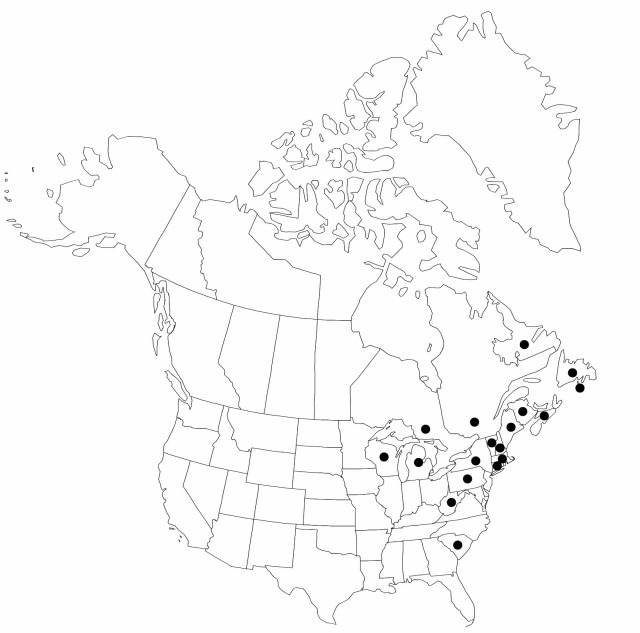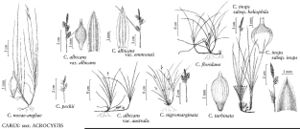Difference between revisions of "Carex novae-angliae"
Ann. Lyceum Nat. Hist. New York 1: 67. 1824.
FNA>Volume Importer |
imported>Volume Importer |
||
| (6 intermediate revisions by 2 users not shown) | |||
| Line 8: | Line 8: | ||
}} | }} | ||
|common_names=Carex de Nouvelle-Angleterre | |common_names=Carex de Nouvelle-Angleterre | ||
| + | |special_status={{Treatment/ID/Special_status | ||
| + | |code=F | ||
| + | |label=Illustrated | ||
| + | }}{{Treatment/ID/Special_status | ||
| + | |code=E | ||
| + | |label=Endemic | ||
| + | }} | ||
|basionyms= | |basionyms= | ||
|synonyms= | |synonyms= | ||
| Line 24: | Line 31: | ||
|elevation=100–1000 m | |elevation=100–1000 m | ||
|distribution=St. Pierre and Miquelon;N.B.;Nfld. and Labr.;N.S.;Ont.;Que.;Conn.;Maine;Mass.;Mich.;N.H.;N.Y.;Pa.;S.C.;Vt.;W.Va.;Wis. | |distribution=St. Pierre and Miquelon;N.B.;Nfld. and Labr.;N.S.;Ont.;Que.;Conn.;Maine;Mass.;Mich.;N.H.;N.Y.;Pa.;S.C.;Vt.;W.Va.;Wis. | ||
| − | |discussion=<p>Recently discovered plants on the coastal plain in South Carolina resemble Carex novae-angliae in habit and perigynium features and have well-developed basal spikes. They require further study to determine their relationships with other members of the section.</p> | + | |discussion=<p>Recently discovered plants on the coastal plain in South Carolina resemble <i>Carex novae-angliae</i> in habit and perigynium features and have well-developed basal spikes. They require further study to determine their relationships with other members of the section.</p> |
|tables= | |tables= | ||
|references= | |references= | ||
| Line 33: | Line 40: | ||
-->{{#Taxon: | -->{{#Taxon: | ||
name=Carex novae-angliae | name=Carex novae-angliae | ||
| − | |||
|authority=Schweinitz | |authority=Schweinitz | ||
|rank=species | |rank=species | ||
| Line 47: | Line 53: | ||
|publication title=Ann. Lyceum Nat. Hist. New York | |publication title=Ann. Lyceum Nat. Hist. New York | ||
|publication year=1824 | |publication year=1824 | ||
| − | |special status= | + | |special status=Illustrated;Endemic |
| − | |source xml=https:// | + | |source xml=https://bitbucket.org/aafc-mbb/fna-data-curation/src/2e0870ddd59836b60bcf96646a41e87ea5a5943a/coarse_grained_fna_xml/V23/V23_1017.xml |
|genus=Carex | |genus=Carex | ||
|section=Carex sect. Acrocystis | |section=Carex sect. Acrocystis | ||
Latest revision as of 20:38, 5 November 2020
Plants loosely cespitose; rhizomes ascending to erect, reddish to reddish brown, 0–10(–20) mm, slender. Culms 5–40 cm, weakly scabrous distally; bases not fibrous. Leaf blades green, equaling or exceeding culms, 0.7–1.5 mm wide, herbaceous, smooth to papillose abaxially, weakly scabrous adaxially. Inflorescences with both staminate and proximal spikes; peduncles of staminate spikes 1.9–5.9 mm; proximal nonbasal bracts leaflike, equaling or shorter than inflorescences. Spikes: proximal pistillate spikes 2–3 (basal spikes 0); cauline spikes remote, nonoverlapping, proximal 2 usually separated by more than 7 mm, with 3–10 perigynia; staminate spikes 4–15 × 0.7–1.3 mm. Scales: pistillate scales pale brown to pale reddish brown, ovate, 2–2.5 × 1–1.4 mm, shorter than to equaling perigynia, apex cuspidate to acuminate; staminate scales oblong to oblanceolate, 3.1–4.6 × 0.7–1.3 mm, apex long-acuminate to obtuse. Anthers 1.5–2.1 mm. Perigynia pale green, veinless, ellipsoid, 2.2–2.6 × 0.8–1 mm, longer than wide; beak 0.3–0.7 mm, straight, pale green, apical teeth 0.2–0.3 mm. Stigmas 3. Achenes dark brown, obovoid to ellipsoid, acutely trigonous in cross section, 1.4–1.7 × 0.7–0.9 mm.
Phenology: Fruiting early Jun–early Jul.
Habitat: Moist to mesic sites, in shade or partial shade under mixed deciduous forests, occasionally under spruce-hemlock canopies
Elevation: 100–1000 m
Distribution

St. Pierre and Miquelon, N.B., Nfld. and Labr., N.S., Ont., Que., Conn., Maine, Mass., Mich., N.H., N.Y., Pa., S.C., Vt., W.Va., Wis.
Discussion
Recently discovered plants on the coastal plain in South Carolina resemble Carex novae-angliae in habit and perigynium features and have well-developed basal spikes. They require further study to determine their relationships with other members of the section.
Selected References
None.
